Papers by Maged N Shaddad
International Journal of Energy Research
International Journal of Energy Research, 2022
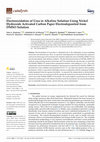
Catalysts, 2021
Electrooxidation of urea plays a substantial role in the elimination of urea-containing wastewate... more Electrooxidation of urea plays a substantial role in the elimination of urea-containing wastewater and industrial urea. Here, we report the electrodeposition of nickel hydroxide catalyst on commercial carbon paper (CP) electrodes from dimethyl sulphoxide solvent (Ni(OH)2-DMSO/CP) for urea electrooxidation under alkaline conditions. The physicochemical features of Ni(OH)2-DMSO/CP catalysts using scanning electron microscopy and X-ray photoelectron spectroscopy revealed that the Ni(OH)2-DMSO/CP catalyst shows nanoparticle features, with loading of <1 wt%. The cyclic voltammetry and electrochemical impedance spectroscopy revealed that the Ni(OH)2-DMSO/CP electrode has a urea oxidation onset potential of 0.33 V vs. Ag/AgCl and superior electrocatalytic performance, which is a more than 2-fold higher activity in comparison with the counterpart Ni(OH)2 catalyst prepared from the aqueous electrolyte. As expected, the enhancement in electrocatalytic activity towards urea was associated w...
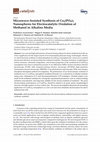
Catalysts, 2017
Low-cost and high-performance advanced electrocatalysts for direct methanol fuel cells are of key... more Low-cost and high-performance advanced electrocatalysts for direct methanol fuel cells are of key significance for the improvement of environmentally-pleasant energy technologies. Herein, we report the facile synthesis of cobalt phosphate (Co 3 (PO 4) 2) nanospheres by a microwave-assisted process and utilized as an electrocatalyst for methanol oxidation. The phase formation, morphological surface structure, elemental composition, and textural properties of the synthesized (Co 3 (PO 4) 2) nanospheres have been examined by powder X-ray diffraction (XRD), Fourier transform-infrared spectroscopy (FT-IR), field emission-scanning electron microscopy (FE-SEM), high-resolution transmission electron microscopy (HRTEM), X-ray photoelectron spectroscopy (XPS), and nitrogen adsorption-desorption isotherm investigations. The performance of an electrocatalytic oxidation of methanol over a Co 3 (PO 4) 2 nanosphere-modified electrode was evaluated in an alkaline solution using cyclic voltammetry (CV) and chronopotentiometry (CP) techniques. Detailed studies were made for the methanol oxidation by varying the experimental parameters, such as catalyst loading, methanol concentration, and long-term stability for the electro-oxidation of methanol. The good electrocatalytic performances of Co 3 (PO 4) 2 should be related to its good surface morphological structure and high number of active surface sites. The present investigation illustrates the promising application of Co 3 (PO 4) 2 nanospheres as a low-cost and more abundant electrocatalyst for direct methanol fuel cells.
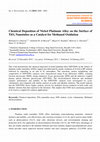
This work demonstrates the chemical deposited of nickel platinum alloy NiPt/TONs on the surface o... more This work demonstrates the chemical deposited of nickel platinum alloy NiPt/TONs on the surface of titanium oxides nanotubes (TONs) support prefabricated by anodic oxidation of Ti foil in HF solution followed by annealing in air and in N 2 atmosphere. The structural, surface morphology and composition of NiPt/TONs catalysts were characterized using X-ray diffraction (XRD), scanning electron microscopy (SEM), energy dispersive X-ray spectroscopy (EDS) and the inductive coupled plasma optical emission spectroscopy (ICP-OES). The electrochemical behavior and methanol catalytic performance and stability of the NiPt/TONs catalysts were investigated by cyclic voltammetry and compared with similar catalysts in acidic and alkaline solutions. The results indicate that the NiPt/TONs shows higher catalytic activity for methanol electro-oxidation in both acidic and alkaline solution than that reported in the literature. This implies that TONs have promising potential to be used as a support for...
Journal of Saudi Chemical Society
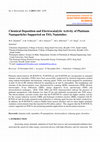
TON-air) incorporated on annealed titanium oxide nanotubes (TONs) have been successfully synthesi... more TON-air) incorporated on annealed titanium oxide nanotubes (TONs) have been successfully synthesized by chemical deposition method using sodium borohydride and hydrazine, reducing agents. TONs were firstly prepared by anodization of pure Ti foil in HF solution followed by annealing in air and N 2 atmosphere. The morphology and structure of the electrocatalysts were characterized by scanning (SEM), transmission (TEM) electron microscopies, X-ray diffraction (XRD), energy dispersive X-ray spectroscopy (EDS) and electrochemical techniques. SEM, TEM, XRD and EDX characterization indicate the presence of platinum nanoparticles with diameter less than 50 nm and uniformly incorporated into TON arrays. The electrocatalytic activities results show that the Pt-B/TON-N 2 catalyst has higher catalytic activity for the oxygen reduction reaction (ORR) and hydrogen evolution reaction (HER) compared with Pt-B/TON-air and electrodes prepared using hydrazine as reducing agent because the better conductivity. In addition, the Pt-B/TON-N 2 catalyst exhibits better poison tolerance and two times higher methanol oxidation current density than that reported for Pt/carbon catalyst. This suggests that the Pt-B/TON-N 2 catalyst supported on TON-N 2 has promising potential applications in electrocatalyst reactions.
International Journal of Hydrogen Energy
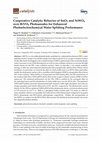
Catalysts
n-BiVO4 is a favorable photoelectrode candidate for a photoelectrochemical (PEC) water splitting ... more n-BiVO4 is a favorable photoelectrode candidate for a photoelectrochemical (PEC) water splitting reaction owing to its suitable energy level edge locations for an oxygen evolution reaction. On the other hand, the sluggish water oxidation kinetics of BiVO4 photoanodes when used individually make it necessary to use a hole blocking layer as well as water oxidation catalysts to overcome the high kinetic barrier for the PEC water oxidation reaction. Here, we describe a very simple synthetic strategy to fabricate nanocomposite photoanodes that synergistically address both of these critical limitations. In particular, we examine the effect of a SnO2 buffer layer over BiVO4 films and further modify the photoanode surface with a crystalline nickel tungstate (NiWO4) nanoparticle film to boost PEC water oxidation. When NiWO4 is incorporated over BiVO4/SnO2 films, the PEC performance of the resultant triple-layer NiWO4/BiVO4/SnO2 films for the oxygen evolution reaction (OER) is further improve...
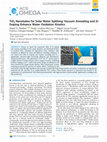
ACS Omega
Herein, we report the cooperative effect of Zr doping and vacuum annealing on the carrier dynamic... more Herein, we report the cooperative effect of Zr doping and vacuum annealing on the carrier dynamics and interfacial kinetics of anodized TiO 2 nanotubes for light-driven water oxidation. After evaluation of different Zr loads and different annealing conditions, it was found that both Zr doping and vacuum annealing lead to a significantly enhanced light harvesting efficiency and photoelectrochemical performance. The substitution of Zr 4+ by Ti 4+ species leads to a higher density of surface defects such as oxygen vacancies, facilitating electron trapping on Zr 4+ , which reduced the charge recombination and hence boosted the charge transfer kinetics. More importantly, vacuum annealing promoted the presence of surface defects. Furthermore, the mechanistic study through impedance spectroscopy revealed that both charge transfer and surface conductivity are significantly enhanced due the presence of an oxygen-deficient TiO 2 surface. These results represent an important step forward in the optimization of nanostructured TiO 2-based photoelectrodes, with high potential in photocatalytic applications, including solar fuel production.
Applied Catalysis B: Environmental
The Journal of Physical Chemistry C
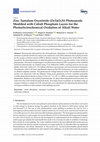
Nanomaterials (Basel, Switzerland), Jan 18, 2018
Photoanodes fabricated by the electrophoretic deposition of a thermally prepared zinc tantalum ox... more Photoanodes fabricated by the electrophoretic deposition of a thermally prepared zinc tantalum oxynitride (ZnTaO₂N) catalyst onto indium tin oxide (ITO) substrates show photoactivation for the oxygen evolution reaction (OER) in alkaline solutions. The photoactivity of the OER is further boosted by the photodeposition of cobalt phosphate (CoPi) layers onto the surface of the ZnTaO₂N photoanodes. Structural, morphological, and photoelectrochemical (PEC) properties of the modified ZnTaO₂N photoanodes are studied using X-ray diffraction (XRD), scanning electron microscopy (SEM), ultraviolet visible (UV-Vis) diffuse reflectance spectroscopy, and electrochemical techniques. The presence of the CoPi layer significantly improved the PEC performance of water oxidation in an alkaline sulphate solution. The photocurrent-voltage behavior of the CoPi-modified ZnTaO₂N anodes was improved, with the influence being more prominent at lower oxidation potentials. A stable photocurrent density of about...

ChemSusChem, 2016
Photoelectrochemical water splitting with metal oxide semiconductors offers a cost-competitive al... more Photoelectrochemical water splitting with metal oxide semiconductors offers a cost-competitive alternative for the generation of solar fuels. Most of the materials studied so far suffer from poor charge-transfer kinetics at the semiconductor/liquid interface, making compulsory the use of catalytic layers to overcome the large overpotentials required for the water oxidation reaction. Herein, we report a very soft electrolytic synthesis deposition method, which allows remarkably enhanced water oxidation kinetics of BiVO4 photoanodes by the sequential addition of Zr and Fe precursors. Upon a heat treatment cycle, these precursors are converted into monoclinic ZrO2 and α-Fe2 O3 nanoparticles, which mainly act as catalysts, leading to a five-fold increase of the water oxidation photocurrent of BiVO4 . This method provides a versatile platform that is easy to apply to different semiconductor materials, fully reproducible, and facile to scale-up on large area conductive substrates with attractive implications for technological deployment.
Hydrogen peroxide (H 2 O 2) is widely used in the chemical industry and environmental protection.... more Hydrogen peroxide (H 2 O 2) is widely used in the chemical industry and environmental protection. The formation of H 2 O 2 by oxygen reduction in alkaline solution using TiO 2 nanotube array catalyst is being explored. TiO 2 nanotube array electrodes are of interest in a wide range of applications and the possibility to fine-tune reactivity to avoid or to promote peroxide formation will be of considerable use and benefit.











Uploads
Papers by Maged N Shaddad